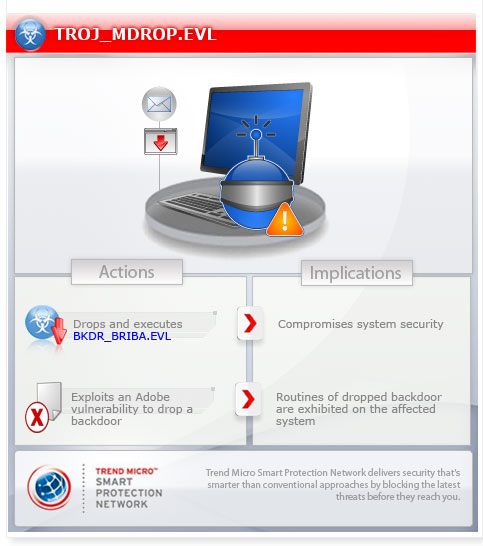TROJ_MDROP.EVL
Exploit:SWF/ShellCode.G (Microsoft), ARC:Embedded (Kaspersky), Trojan.Mdropper (Symantec), MSWord/SWFDropper.A!Camelot (Authentium)
Windows 2000, Windows XP, Windows Server 2003


Threat Type: Trojan
Destructiveness: No
Encrypted:
In the wild: Yes
OVERVIEW
This Trojan exploits CVE-2012-1535, an Adobe vulnerability that is already patched before the release of this Trojan.
To get a one-glance comprehensive view of the behavior of this Trojan, refer to the Threat Diagram shown below.

This Trojan arrives as an attachment to email messages spammed by other malware/grayware or malicious users. It may be downloaded by other malware/grayware/spyware from remote sites. It may be manually installed by a user.
It executes the dropped file(s). As a result, malicious routines of the dropped files are exhibited on the affected system.
TECHNICAL DETAILS
Arrival Details
This Trojan arrives as an attachment to email messages spammed by other malware/grayware or malicious users.
It may be downloaded by other malware/grayware/spyware from remote sites.
It may be manually installed by a user.
Installation
This Trojan drops and executes the following files:
- %User Profile%\Local Settings\~WORDL.tmp - detected as BKDR_BRIBA.EVL
- %User Profile%\Application Data\taskman.dll - detected as BKDR_BRIBA.EVL
(Note: %User Profile% is the current user's profile folder, which is usually C:\Windows\Profiles\{user name} on Windows 98 and ME, C:\WINNT\Profiles\{user name} on Windows NT, and C:\Documents and Settings\{user name} on Windows 2000, XP, and Server 2003.)
Dropping Routine
This Trojan takes advantage of the following software vulnerabilities to drop malicious files:
It executes the dropped file(s). As a result, malicious routines of the dropped files are exhibited on the affected system.
NOTES:
This is the Trend Micro detection for a Microsoft Office Word document with an embedded malicious Flash file.
SOLUTION
Step 1
For Windows XP and Windows Server 2003 users, before doing any scans, please make sure you disable System Restore to allow full scanning of your computer.
Step 3
Scan your computer with your Trend Micro product to delete files detected as TROJ_MDROP.EVL. If the detected files have already been cleaned, deleted, or quarantined by your Trend Micro product, no further step is required. You may opt to simply delete the quarantined files. Please check this Knowledge Base page for more information.
Step 4
Download and apply this security patch Refrain from using these products until the appropriate patches have been installed. Trend Micro advises users to download critical patches upon release by vendors.
Did this description help? Tell us how we did.

